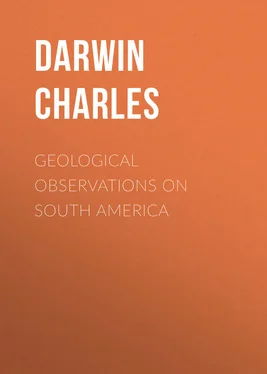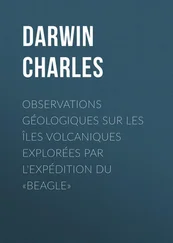Charles Darwin - Geological Observations on South America
Здесь есть возможность читать онлайн «Charles Darwin - Geological Observations on South America» — ознакомительный отрывок электронной книги совершенно бесплатно, а после прочтения отрывка купить полную версию. В некоторых случаях можно слушать аудио, скачать через торрент в формате fb2 и присутствует краткое содержание. Жанр: foreign_antique, foreign_prose, на английском языке. Описание произведения, (предисловие) а так же отзывы посетителей доступны на портале библиотеки ЛибКат.
- Название:Geological Observations on South America
- Автор:
- Жанр:
- Год:неизвестен
- ISBN:нет данных
- Рейтинг книги:3 / 5. Голосов: 1
-
Избранное:Добавить в избранное
- Отзывы:
-
Ваша оценка:
- 60
- 1
- 2
- 3
- 4
- 5
Geological Observations on South America: краткое содержание, описание и аннотация
Предлагаем к чтению аннотацию, описание, краткое содержание или предисловие (зависит от того, что написал сам автор книги «Geological Observations on South America»). Если вы не нашли необходимую информацию о книге — напишите в комментариях, мы постараемся отыскать её.
Geological Observations on South America — читать онлайн ознакомительный отрывок
Ниже представлен текст книги, разбитый по страницам. Система сохранения места последней прочитанной страницы, позволяет с удобством читать онлайн бесплатно книгу «Geological Observations on South America», без необходимости каждый раз заново искать на чём Вы остановились. Поставьте закладку, и сможете в любой момент перейти на страницу, на которой закончили чтение.
Интервал:
Закладка:
Although in the foregoing discussion I have assumed the elevation to have been horizontal, it may be suspected, from the considerable seaward slope of the terraces, both up the valley of S. Cruz and up that of Coquimbo, that the rising has been greater inland than nearer the coast. There is reason to believe (Mr. Place in the "Quarterly Journal of Science" 1824 volume 17 page 42.), from the effects produced on the water-course of a mill during the earthquake of 1822 in Chile, that the upheaval one mile inland was nearly double, namely, between five and seven feet, to what it was on the Pacific. We know, also, from the admirable researches of M. Bravais, that in Scandinavia the ancient sea-beaches gently slope from the interior mountain-ranges towards the coast, and that they are not parallel one to the other ("Voyages de la Comm. du Nord" etc. also "Comptes Rendus" October 1842.), showing that the proportional difference in the amount of elevation on the coast and in the interior, varied at different periods.
COQUIMBO TO GUASCO.
In this distance of ninety miles, I found in almost every part marine shells up to a height of apparently from two hundred to three hundred feet. The desert plain near Choros is thus covered; it is bounded by the escarpment of a higher plain, consisting of pale-coloured, earthy, calcareous stone, like that of Coquimbo, with the same recent shells embedded in it. In the valley of Chaneral, a similar bed occurs in which, differently from that of Coquimbo, I observed many shells of the Concholepas: near Guasco the same calcareous bed is likewise met with.
In the valley of Guasco, the step-formed terraces of gravel are displaced in a more striking manner than at any other point. I followed the valley for thirty-seven miles (as reckoned by the inhabitants) from the coast to Ballenar; in nearly the whole of this distance, five grand terraces, running at corresponding heights on both sides of the broad valley, are more conspicuous than the three best-developed ones at Coquimbo. They give to the landscape the most singular and formal aspect; and when the clouds hung low, hiding the neighbouring mountains, the valley resembled in the most striking manner that of Santa Cruz. The whole thickness of these terraces or plains seems composed of gravel, rather firmly aggregated together, with occasional parting seams of clay: the pebbles on the upper plain are often whitewashed with an aluminous substance, as in Patagonia. Near the coast I observed many sea-shells on the lower plains. At Freyrina (twelve miles up the valley), there are six terraces beside the bottom- surface of the valley: the two lower ones are here only from two hundred to three hundred yards in width, but higher up the valley they expand into plains; the third terrace is generally narrow; the fourth I saw only in one place, but there it was distinct for the length of a mile; the fifth is very broad; the sixth is the summit-plain, which expands inland into a great basin. Not having a barometer with me, I did not ascertain the height of these plains, but they appeared considerably higher than those at Coquimbo. Their width varies much, sometimes being very broad, and sometimes contracting into mere fringes of separate flat-topped projections, and then quite disappearing: at the one spot, where the fourth terrace was visible, the whole six terraces were cut off for a short space by one single bold escarpment. Near Ballenar (thirty-seven miles from the mouth of the river), the valley between the summit-edges of the highest escarpments is several miles in width, and the five terraces on both sides are broadly developed: the highest cannot be less than six hundred feet above the bed of the river, which itself must, I conceive, be some hundred feet above the sea.
A north and south section across the valley in this part is represented in
Figure 12.
(FIGURE 12. NORTH AND SOUTH SECTION ACROSS THE VALLEY OF GUASCO, AND OF A PLAIN NORTH OF IT.
From left (north, high) to right (south, high) through plains B and A and the River of Guasco at the Town of Ballenar.)
On the northern side of the valley the summit-plain of gravel, A, has two escarpments, one facing the valley, and the other a great basin-like plain, B, which stretches for several leagues northward. This narrow plain, A, with the double escarpment, evidently once formed a spit or promontory of gravel, projecting into and dividing two great bays, and subsequently was worn on both sides into steep cliffs. Whether the several escarpments in this valley were formed during the same stationary periods with those of Coquimbo, I will not pretend to conjecture; but if so the intervening and subsequent elevatory movements must have been here much more energetic, for these plains certainly stand at a much higher level than do those of Coquimbo.
COPIAPO.
From Guasco to Copiapo, I followed the road near the foot of the Cordillera, and therefore saw no upraised remains. At the mouth, however, of the valley of Copiapo there is a plain, estimated by Meyen ("Reise um die Erde" th. 1 s. 372 et seq.) between fifty and seventy feet in height, of which the upper part consists chiefly of gravel, abounding with recent shells, chiefly of the Concholepas, Venus Dombeyi, and Calyptraea trochiformis. A little inland, on a plain estimated by myself at nearly three hundred feet, the upper stratum was formed of broken shells and sand cemented by white calcareous matter, and abounding with embedded recent shells, of which the Mulinia Byronensis and Pecten purpuratus were the most numerous. The lower plain stretches for some miles southward, and for an unknown distance northward, but not far up the valley; its seaward face, according to Meyen, is worn into caves above the level of the present beach. The valley of Copiapo is much less steeply inclined and less direct in its course than any other valley which I saw in Chile; and its bottom does not generally consist of gravel: there are no step-formed terraces in it, except at one spot near the mouth of the great lateral valley of the Despoblado where there are only two, one above the other: lower down the valley, in one place I observed that the solid rock had been cut into the shape of a beach, and was smoothed over with shingle.
Northward of Copiapo, in latitude 26 degrees S., the old voyager Wafer found immense numbers of sea-shells some miles from the coast. (Burnett's "Collection of Voyages" volume 4 page 193.) At Cobija (latitude 22 degrees 34') M. d'Orbigny observed beds of gravel and broken shells, containing ten species of recent shells; he also found, on projecting points of porphyry, at a height of 300 feet, shells of Concholepas, Chiton, Calyptraea, Fissurella, and Patella, still attached to the spots on which they had lived. M. d'Orbigny argues from this fact, that the elevation must have been great and sudden ("Voyage, Part Geolog." page 94. M. d'Orbigny (page 98), in summing up, says: "S'il est certain (as he believes) que tous les terrains en pente, compris entre la mer et les montagnes sont l'ancien rivage de la mer, on doit supposer, pour l'ensemble, un exhaussement que ce ne serait pas moindre de deux cent metres; il faudrait supposer encore que ce soulevement n'a point ete graduel;…mais qu'il resulterait d'une seule et meme cause fortuite," etc. Now, on this view, when the sea was forming the beach at the foot of the mountains, many shells of Concholepas, Chiton, Calyptraea, Fissurella, and Patella (which are known to live close to the beach), were attached to rocks at a depth of 300 feet, and at a depth of 600 feet several of these same shells were accumulating in great numbers in horizontal beds. From what I have myself seen in dredging, I believe this to be improbable in the highest degree, if not impossible; and I think everyone who has read Professor E. Forbes's excellent researches on the subject, will without hesitation agree in this conclusion.): to me it appears far more probable that the movement was gradual, with small starts as during the earthquakes of 1822 and 1835, by which whole beds of shells attached to the rocks were lifted above the subsequent reach of the waves. M. d'Orbigny also found rolled pebbles extending up the mountain to a height of at least six hundred feet. At Iquique (latitude 20 degrees 12' S.), in a great accumulation of sand, at a height estimated between one hundred and fifty and two hundred feet, I observed many large sea-shells which I thought could not have been blown up by the wind to that height. Mr. J.H. Blake has lately described these shells: he states that "inland toward the mountains they form a compact uniform bed, scarcely a trace of the original shells being discernible; but as we approach the shore, the forms become gradually more distinct till we meet with the living shells on the coast." ("Silliman's American Journal of Science" volume 44 page 2.) This interesting observation, showing by the gradual decay of the shells how slowly and gradually the coast must have been uplifted, we shall presently see fully confirmed at Lima. At Arica (latitude 18 degrees 28'), M. d'Orbigny found a great range of sand-dunes, fourteen leagues in length, stretching towards Tacna, including recent shells and bones of Cetacea, and reaching up to a height of 300 feet above the sea. ("Voyage" etc. page 101.) Lieutenant Freyer has given some more precise facts: he states (In a letter to Mr. Lyell "Geological Proceedings" volume 2 page 179.) that the Morro of Arica is about four hundred feet high; it is worn into obscure terraces, on the bare rock of which he found Balini and Milleporae adhering. At the height of between twenty and thirty feet the shells and corals were in a quite fresh state, but at fifty feet they were much abraded; there were, however, traces of organic remains at greater heights. On the road from Tacna to Arequipa, between Loquimbo and Moquegua, Mr. M. Hamilton found numerous recent sea shells in sand, at a considerable distance from the sea. ("Edinburgh New Philosophical Journal" volume 30 page 155.)
Читать дальшеИнтервал:
Закладка:
Похожие книги на «Geological Observations on South America»
Представляем Вашему вниманию похожие книги на «Geological Observations on South America» списком для выбора. Мы отобрали схожую по названию и смыслу литературу в надежде предоставить читателям больше вариантов отыскать новые, интересные, ещё непрочитанные произведения.
Обсуждение, отзывы о книге «Geological Observations on South America» и просто собственные мнения читателей. Оставьте ваши комментарии, напишите, что Вы думаете о произведении, его смысле или главных героях. Укажите что конкретно понравилось, а что нет, и почему Вы так считаете.












